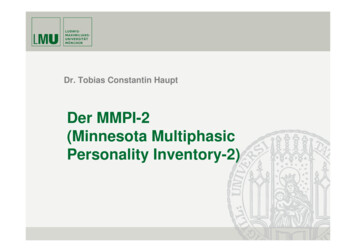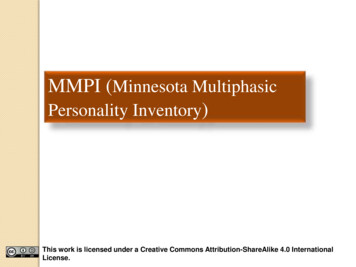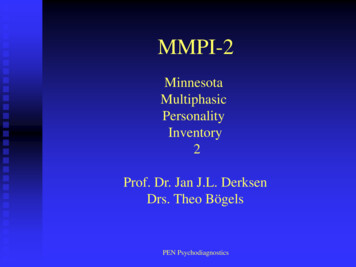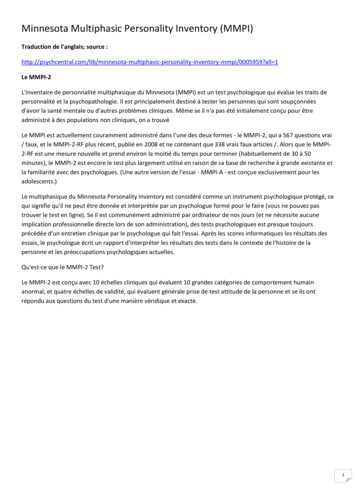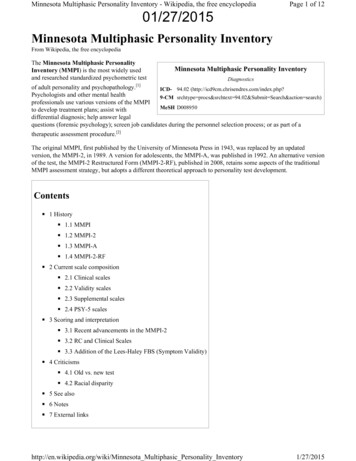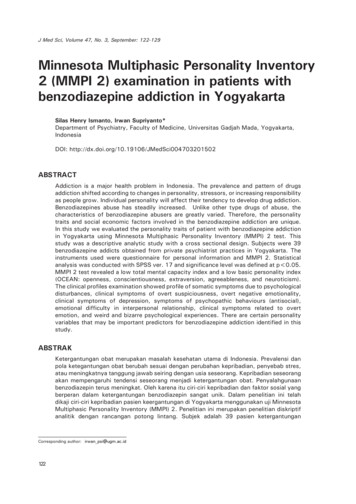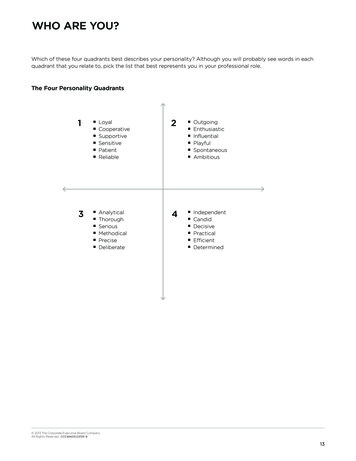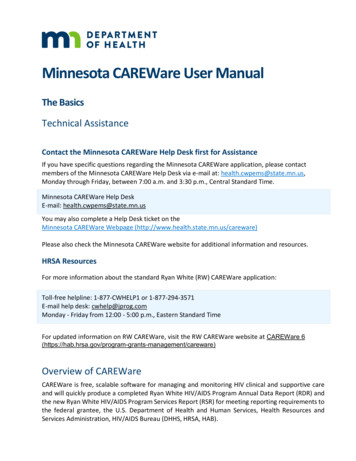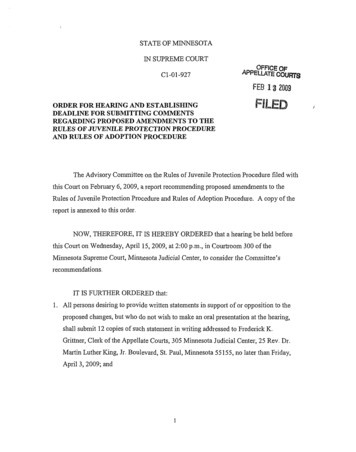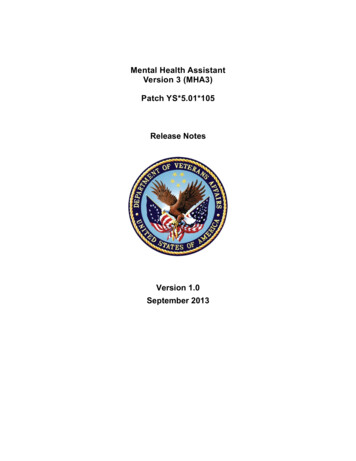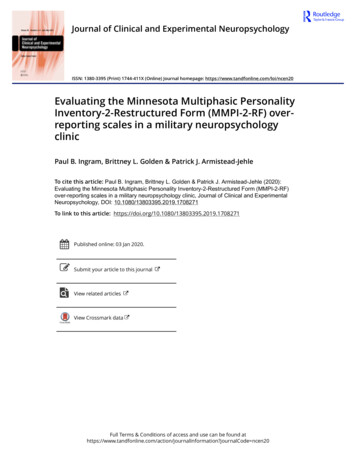
Transcription
Journal of Clinical and Experimental NeuropsychologyISSN: 1380-3395 (Print) 1744-411X (Online) Journal homepage: https://www.tandfonline.com/loi/ncen20Evaluating the Minnesota Multiphasic PersonalityInventory-2-Restructured Form (MMPI-2-RF) overreporting scales in a military neuropsychologyclinicPaul B. Ingram, Brittney L. Golden & Patrick J. Armistead-JehleTo cite this article: Paul B. Ingram, Brittney L. Golden & Patrick J. Armistead-Jehle (2020):Evaluating the Minnesota Multiphasic Personality Inventory-2-Restructured Form (MMPI-2-RF)over-reporting scales in a military neuropsychology clinic, Journal of Clinical and ExperimentalNeuropsychology, DOI: 10.1080/13803395.2019.1708271To link to this article: shed online: 03 Jan 2020.Submit your article to this journalView related articlesView Crossmark dataFull Terms & Conditions of access and use can be found ation?journalCode ncen20
JOURNAL OF CLINICAL AND EXPERIMENTAL 19.1708271Evaluating the Minnesota Multiphasic Personality Inventory-2-RestructuredForm (MMPI-2-RF) over-reporting scales in a military neuropsychology clinicPaul B. Ingrama,b, Brittney L. Goldena and Patrick J. Armistead-JehlecaDepartment of Psychological Sciences, Texas Tech University, Lubbock, TX, USA; bDwight D. Eisenhower VAMC, Eastern Kansas VeteranHealthcare System, Leavenworth, KS, USA; cMunson Army Health Center, Concussion Clinic, Fort Leavenworth, KS, USAABSTRACTARTICLE HISTORYIntroduction: This study examines the utility of the Minnesota Multiphasic Personality Inventory2-Restructured Form (MMPI-2-RF) validity scales to detect invalid responding within a sample ofactive duty United States Army soldiers referred for neuropsychological evaluations.Method: This study examines the relationship between performance validity testing and performance on the MMPI-2-RF over-reporting scales. Specifically, mean differences between those whopassed (n 152; 75.6%) or failed (n 49; 24.4%) performance validity testing were compared.Receiver operator characteristic analyzes were also conducted to expand available information onthe MMPI-2-RF over-reporting sensitivity and specificity in an Army sample.Results: This study has two distinct findings. First, effect size differences between those passingand failing performance validity testing are classified as small to medium in magnitude (rangingfrom d . 30/g .32 on F-r to d .66/g .73 on RBS). Second, over-reporting scales have higherspecificity and poorer sensitivity. Likewise, performance of the over-reporting scales suggests thatthose who exceeding recommended cut scores are likely to have failed extra-test performancevalidity measures.Conclusion: These findings suggest that many who fail external performance measures may beundetected on the MMPI-2-RF over-reporting scales and that those exceeding recommended cutscores are likely to have failed extra-test performance validity testing. Implications for research on,and practice with, the MMPI-2-RF in military populations are discussed.Received 28 May 2019Accepted 13 December 2019The Minnesota Multiphasic Personality Inventory–2–Restructured Form (MMPI-2-RF; Ben-Porath &Tellegen, 2008/2011) is amongst the most widely usedinstruments assessing psychopathology (Wright et al.,2017). In fact, in recent surveys of Veteran Affairs (VA)providers it was used more frequently than any otherpersonality inventory during neuropsychological evaluations (Russo, 2018) and, more generally, it is amongthe most utilized symptom validity test (Young, Roper,& Arentsen, 2016). This wide-ranging use is likelybecause of the MMPI-2-RF’s abbreviated length andnoted improvements in psychometric strengths (e.g.,Simms, Casillas, Clark, Watson, & Doebbeling, 2005).In addition to measuring under-reporting and acquiescent responding, the MMPI-2-RF has five validity scalesassessing over-reporting. Three over-reporting scaleswere revised versions of scales developed on theMMPI-2 (e.g., Infrequent Responses [F-r], InfrequentPsychopathology Responses [Fp-r], and SymptomValidity [FBS-r]; Ben-Porath, 2012). However,Response Bias (RBS; Gervais, Ben-Porath, Wygant, &KEYWORDSMMPI-2-RF; feigning;military; validity testing;over-reportingGreen, 2007) and Infrequent Somatic Complaints (Fs;Wygant, Ben-Porath, & Arbisi, 2004) were introducedto strengthen an under-assessed area of over-reporting(infrequent somatic complaints in Fs) and to provide analternative approach to identifying feigners (excessivefailure of external performance validity tests [PVT] inRBS). Effective detection of over-reporting is importantas it otherwise leads to weaker substantive scale relationships and reduces the predictive utility of validatedassessments (Burchett & Ben-Porath, 2010; Wershba,Locke, & Lanyon, 2015; Wiggins, Wygant, Hoelzle, &Gervais, 2012).Recently, two meta-analyzes have synthesized theliterature on these five over-reporting scales. Both studies found substantially large effect sizes differentiatinghonest respondents and those identified as exaggeratingor feigning their symptoms (Ingram & Ternes, 2016;Sharf, Rogers, Williams, & Henry, 2017). In additionto general support for the efficacy of the MMPI-2-RFover-reporting scales, Ingram and Ternes identifiednumerous moderators influencing the effectiveness ofCONTACT Paul B. Ingrampbingram@gmail.comDepartment of Psychological Sciences, Texas Tech University, Lubbock, TX, USAThe views, opinions, and/or findings contained in this article are those of the authors and should not be construed as an official Department of the Army,Department of Veteran Affairs, Department of Defense, or U.S. Government position, policy or decision unless so designated by other official documentation. 2020 Informa UK Limited, trading as Taylor & Francis Group
2P. B. INGRAM ET AL.those scales, including some related to military service(e.g., veteran status, posttraumatic stress disorder[PTSD]).Such moderation across the MMPI-2-RF’s overreporting scales is not surprising given that militaryservice is a distinctive identity component for thosewho have served (Orazem et al., 2017) and that thosewith military service consistently demonstrate differences in their clinical presentation and evaluativeneeds. For instance, despite similarities in many treatments and principles of practice, traumatic brain injuryand PTSD pose distinctive challenges for mental healthproviders conducting evaluations and providing treatment to those with military service (Armistead-Jehle,Soble, Cooper, & Belanger, 2017; Coll & Weiss, 2016;Dursa, Reinhard, Barth, & Schneiderman, 2014).Indeed, the prevalence of disorders amongst thosewith military service histories are distinct from the general population, resulting in unique health epidemics(e.g., Kilpatrick et al., 2013). Ingram and Ternes (2016)also noted a relative paucity of research assessing military and veteran samples relative to other populations.Given the patterns of moderation they found on theMMPI-2-RF validity scales for domains related to military service, a more limited literature is problematic.Several studies have evaluated the MMPI-2-RF validityscales in samples with psychiatric and neuropsychologicalproblems common among military personnel; however,most of these studies have utilized veteran participantsrather than active duty or other current service members.Research has included simulation studies with veteransexperimentally feigning common psychopathologies(e.g., Goodwin, Sellbom, & Arbisi, 2013), as well asdescriptive findings from clinically derived samples.Findings from clinically derived samples are particularlyimportant because simulation studies over-estimate whatwill be observed during clinical evaluation (e.g., Ingram &Ternes, 2016). For instance, Jurick et al. (2018) found thatamong Operation Enduring Freedom/Operation IraqiFreedom (OEF/OIF) veterans, those with mild traumaticbrain injury (mTBI) were likely to demonstrate symptomexaggeration on one or more MMPI-2-RF over-reportingscales, with the frequency of invalidity ranging from50–87%, depending upon the cut score used. This highrate of profile invalidity is consistent with other researchon mTBI in veterans (Nelson et al., 2011) and may reflecta broader pattern of response style for veterans (e.g.,Ingram, Tarescavage, Ben-Porath, & Oehlert, 2019a,2019b, 2019c), rather than the unique influence ofmTBI on performance. This is likely, in part, due to theevaluative context in which testing is done within the VArelative to disability evaluations (Armistead-Jehle, 2010;Russo, 2017) although other factors, including evaluativepresentation and the severity/frequency of clinical need,also play a role (Ingram et al., 2019a).While veterans have similar service experiences ascurrent military personnel, results from studies onveterans are not likely to offer the best comparisons orestimates of effect to those in active duty roles. There area variety of potential reasons for this, including therecency of traumatic or blast injury events in militarypersonnel or an extended opportunity for psychologicalcare following the event for veterans. Time since injuryis, after all, an important component of clinical presentation for some of the very concerns which make theexperiences of military service and active-duty populations distinct (see Iverson, 2005). Another possible reason is that a disability evaluation may mean somethingdistinct for someone who is currently serving comparedto when a veteran undergoes a similar evaluation (e.g.,return to duty decisions rather than monetary andmedical benefit compensation). As such, the disabilitycompensation process inherent to the Veteran Affairssystem where many veterans receive their services isforensically enmeshed, producing a distinctive evaluation process (Russo, 2013). This setting may, as a resultof this process, alter the effectiveness and clinical utilityof the validity scales (Ingram & Ternes, 2016; Sharfet al., 2017).Research utilizing only military personnel to assess theutility of the MMPI-2-RF over-reporting scales is morelimited than research on veterans. Jones and Ingram(2011) used an optimal data analysis (ODA) paradigmto assess validity scale classification accuracy and foundthat the medium effect sizes of FBS-r and RBS were betterthan the small to medium effects of the F-family of scales.Conversely, when examining mean differences, Jones(2016a) found large effect sizes (d .85–2.01) differentiating between identified non-feigners and groups comprising a variety of levels of feigning certainty (e.g., probable,probable to definite, and definite) in a sample of Armyservice personnel undergoing neuropsychological evaluation. Jones also found that MMPI-2-RF scales had highspecificity, and that RBS had the largest overall effect sizeof the over-reporting scales (d 1.58). RBS was the mosteffective scale in differentiating between military members who passed and failed PVTs, which is consistent withprevious research on military service members undergoing neuropsychological evaluations (Jones, Ingram, &Ben-Porath, 2012).In short, studies with military personnel have generally found that those exceeding recommended cutscores on the MMPI-2-RF are likely to fail concurrenttests of symptom or performance validity (e.g.,Armistead-Jehle, Cooper et al., 2017; Bodapati et al.,2018). Moreover, estimations of classification accuracy
JOURNAL OF CLINICAL AND EXPERIMENTAL NEUROPSYCHOLOGYvary somewhat depending upon the analytical approachutilized (e.g., effect sizes are no more than moderateusing an ODA approach but are large in magnitudewhen comparing mean differences in the same sample;see Jones & Ingram, 2011); however, RBS appears toconsistently function as the most effective overreporting scale. Despite this consensus, there remainsa relative paucity of research on over-reporting in activeduty military samples. Given this, and the broader needfor improved neuropsychological testing in active dutypersonnel (Friedl et al., 2007), further investigation intothe efficacy of the over-reporting scales of the MMPI2-RF is warranted.Present studyThe clinical needs and evaluative context common tomilitary personnel make the efficacy of the overreporting scales within an Army service personnelpopulation unique. There is also a shortage of researchevaluating the efficacy of the MMPI-2-RF overreporting scales within military samples. Accordingly,continued research is warranted to expand availableinformation on the utility and efficacy of the MMPI2-RF in military service members. Therefore, this studyutilizes a sample of U.S. Army soldiers undergoinga neuropsychological evaluation at a neuropsychologyclinic to examine the ability of the over-reporting scalesto differentiate between those who passed or failed performance validity tests (PVT). Specifically, we evaluateMMPI-2-RF over-reporting scale score differences,compute the frequency of those exceeding interpretiverecommendations, calculate the sensitivity (true positiverate) and specificity (true negative rate) of the validityscales, and provide collaborative neuropsychologicaltesting data between those passing and failing PVT(s).MethodParticipantsThis study utilized an initial sample of 216 (88.8% male;73.1% White) active duty United States Army servicemembers evaluated in an outpatient neuropsychologicalclinic. Evaluations occurred between June 2016 andAugust 2018 at a midwestern United States ArmyHealth Center. Participants undergoing medical board(MEB) (n 13) or Temporary Disability Evaluation(TED) (n 2) were removed from this sample.Following this exclusion, the study’s final sample wascomposed of 201 (88.6% male; 72.6% White) active dutyArmy service members. In general, participants were334.5 years old (SD 8.5), had an average of 14.9 yearsof education (SD 2.5), and composed of approximately equal portions of enlisted and officers. Most ofthe referrals to this clinic are concussion-related; however, the clinic is responsible for other evaluations aswell. In terms of neurological diagnosis, 49.3% wereidentified as having a history of mild traumatic braininjury (mTBI) and/or concussion. The average timesince the last TBI was 72.9 months (SD 68.7) andsince the most significant TBI injury was 87.2 months(SD 81.0). Approximately eighty percent of the samplewas diagnosed with a psychiatric condition (82.6%),with the most common diagnoses being an anxiety disorder (27.9%), a depressive disorder (17.9%), attentiondeficit hyperactivity disorder (10.4%), PTSD (8.5%),Adjustment Disorder (5.5%), PTSD and a depressivedisorder (3.0%), or another disorder (9%). In general,those passing and failing PVT(s) were descriptivelysimilar. Available demographic information for participants is provided in Table 1, including informationseparately for those who passed and failed PVT(s).Table 1. Extended participant demographics.VariableGender (Male)EthnicityWhiteAfrican AmericanHispanicAsianNative American/Pacific IslanderOtherDiagnosismTBI/History of ConcussionPsychiatric IssuesOtherNoneMarital StatusMarriedSingleDivorcedLegally SeparatedPsychiatric DiagnosisPTSDDDPTSD and DDSUDOther ull SampleFailedPVT(s)PassedPVT(s)(n 201)(n 49)(n 152)n%n%n%178 88.6% 45 91.8% 133 87.5%146 72.6% 28 57.1% 118 77.6%25 12.4% 10 20.4% 15 9.9%19 9.5% 10 20.4% 95.9%73.5% 0 0.0% 74.6%31.5% 0 0.0% 32.0%10.5% 1 2.0% 00.0%99 49.3% 30 61.2%63 31.3% 10 20.4%15 7.5% 4 8.2%24 11.9% 5 10.2%69 45.4%53 34.9%11 7.2%19 12.5%152 75.6% 35 71.4% 117 77.0%28 13.9% 10 20.4% 18 11.8%17 8.5% 2 4.1% 15 9.9%42.0% 2 4.1% .6%11.8%7.9%19.1%104 51.7% 30 61.2% 74 48.7%97 48.3% 19 38.8% 78 51.3%DD depressive disorder, PTSD posttraumatic stress disorder,SUD substance use disorder, ADHD attention-deficit hyperactivitydisorder.
4P. B. INGRAM ET AL.MeasuresMMPI-2-restructured formThe MMPI-2-RF (Ben-Porath & Tellegen, 2008/2011) isa 338 true-false item personality measure comprised of51 scales. The 42 substantive scales measure variousclinical constructs and have demonstrated validity ina variety of military and veteran samples (e.g., Arbisi,Polusny, Erbes, Thuras, & Reddy, 2011; Goodwin et al.,2013; Gottfried, Bodell, Carbonell, & Joiner, 2014;Ingram et al., 2019a, 2019b). The nine validity scalesare used to determine if a respondent is engaging insome form of non-credible responding (non-contentbased invalid responding, over-reporting, or underreporting). The MMPI-2-RF technical manual describesthe following T-scores as indicating profile invalidity:VRIN-r 80, TRIN-r 80, F-r 120, Fp-r 100,Fs 100, RBS 100, FBS-r 100, L-r 80, andK-r 70. The validity scales of the MMPI-2-RF haveconsistently demonstrated large effect sizes betweengroups passing or failing performance and symptomvalidity tests (Ingram & Ternes, 2016; Sharf et al.,2017). Within military disability samples specifically,the RBS and FBS-r scales outperform the F-family ofscales in classification accuracy (Jones & Ingram, 2011;Jones et al., 2012). In this sample, the MMPI-2-RF waselectronically administered resulting in no missing dataor elevations on the Cannot Say (CNS) scale.Performance validityTo establish performance validity against which theefficacy of the MMPI-2-RF over-reported scales couldbe compared, participants were given at least one ofthree common measures of performance validity.Performance validity relies on quantifiable test performance, typically on tests of memory and cognition,while symptom validity tests evaluate symptom frequency, intensity, duration, and presentation to determine the probability that those symptoms would occur.In our sample, all were administered at least two PVTsand roughly one quarter (26.4%) were administered allthree PVTs. Of those individuals with failed performance validity testing, most failed a single PVT (n 39; 79.6%) while a few failed two (n 8; 16.3%) orthree PVTs (n 2; 5.1%). As such, our sample is bestclassified as possible malingering for those failing PVTtesting (Slick, Sherman, & Iverson, 1999).While the MMPI-2-RF scales evaluate symptom validity, measures of performance validity are often used toevaluate the validity of the MMPI-2-RF over-reportingscales. This is particularly pronounced in clinics andpopulations with cognitive complaint concerns (e.g.,Gervais et al., 2017; Rogers et al., 2011; Wygant et al.,2010). PVTs were also utilized during the developmentand validation of the RBS scale by guiding item selectionprocesses (Gervais et al., 2007). Each PVT indicatorwithin this study has a lengthy history supporting theiruse for the detection of low performance effort. A briefsummary of the psychometric properties of each PVTutilized within this study is outlined below, along withthe portion of individuals identified as having failed thatperformance indicator.Test of memory malingering. The Test of MemoryMalingering (TOMM; Tombaugh, 1996) is a widelyused memory assessment which evaluates inadequateor feigned responding to a typical memory task usinga visual recognition task. Across Sollman and Berry’s(2011) meta-analytic review, the TOMM demonstrated a very large (d 1.59) effect size as well ashigh mean sensitivity (69%) and specificity (90%)across studies on feigned memory complaints. Inthis study, all participants were administered theTOMM and 11 (5.5%) were classified as having failedusing the criteria of a score of less than or equal to 44on Trial 2. A score of equal to or less than 44 is therecommended guideline for the TOMM because only2% of those who are non-demented meet or exceedthis score (Tombaugh, 1996). In this sample, 11 individuals failed the TOMM based on these criteria.Effort index of the RBANS. The effort index (EI;Silverberg, Wertheimer, & Fichtenberg, 2007) of ogical Status (RBANS; Randolph, 1998) isa composite index based on two instrument subtestsusing a scaling system. Research on the EI index hasdemonstrated mixed results regarding its effectivenessas an internal validity indicator. In studies drawn frommilitary samples, the EI has demonstrated consistentevidence of good positive and negative predictive valuesand, in cases of definite malingering, an EI of 1 demonstrated a .89 sensitivity and .97 specificity (Jones, 2016b).Contrasting that universal effectiveness, researchers havenoted that the EI may not be ideal because of its lowersensitivity (Armistead-Jehle & Hansen, 2011). However,the rates of specificity (e.g., the rate at which individualsare correctly identified as not having extra-test evidenceof performance invalidity) are consistently high ( .80).In this study, 53 participants were administered theRBANS and 9 (21.9%) had an EI score of 1 or greaterand were classified as having failed the RBANS EI.Medical symptom validity test. The Medical SymptomValidity Test (MSVT; Green, 2004) involves a 10-itemverbal memory task which assesses performance
JOURNAL OF CLINICAL AND EXPERIMENTAL NEUROPSYCHOLOGYvalidity. After 10 minutes, participants are asked torecall the verbal memory prompts. Research has consistently supported the MSVT’s utility to identify simulated memory impairment and inadequate performanceeffort, including amongst those with mild traumaticbrain injury (e.g., Green, Flaro, Brockhaus, & Montijo,2012; Howe, Anderson, Kaufman, Sachs, & Loring,2007). Likewise, meta-analytic results have shown theMSVT to have large between group effects (d .94) aswell as high sensitivity (70.0%) and specificity (91.3%)(see Sollman & Berry, 2011). The MSVT assesses effortwhen performance is less than or equal to 85% onImmediate Recognition, Delayed Recognition, orConsistency subtests. The Manual reports sensitivity ofapproximately 97% in simulator studies (Green, 2004)and in cases of possible dementia the sensitivity isbetween 90 and 100% (Howe & Loring, 2009; Singhal,Green, Ashaye, Shankar, & Gill, 2009). In this study, allparticipants were administered the MSVT and 41(20.4%) failed the MSVT effort tests.Procedures and planned analysisParticipants were referred for neuropsychological evaluation largely by primary care or behavioral healthproviders. Data was collected by a psychometristunder the supervision of a board-certified neuropsychologist (the third author of this paper) who providedclinical interpretations and diagnostic formulationsbased on testing results. This project received IRBapproval from the Madigan Army Medical Center toconduct analyzes on an anonymized version of theclinical database in which testing results from theseevaluations were stored. Respondents were groupedbased on their PVT performance (pass all/failed atleast one). Individuals were identified for the failedgroup when scores on any administered PVT indicateda pattern of probable or possible invalid responding.Differences between groups were calculated for eachover-reporting scale using independent t-tests.Receiver operator characteristic (ROC) analyzes wereplanned for each of the over-reporting scales to determine sensitivity and specificity for the MMPI-2-RFvalidity scales at various cut scores. Lastly, consistentwith how the MMPI-2-RF is used clinically, positive andnegative predictive value (PPV and NPV, respectively)were calculated when utilizing the MMPI-2-RF overreporting scales conjunctively to determine profile classification accuracy. Effect size estimates were calculatedusing observed means using Cohen’s d, as well asHedge’s g (a sample size adjusted estimator of effect).By providing both effect size estimates, this study can ntly use Cohen’s d) and provides more accurate estimates. An a priori determination of clinicallymeaningful differences between groups was made usinga medium effect size – the equivalent of 5 T-score points(Rosnow, Rosenthal, & Rubin, 2000).ResultsFollowing exclusion for random (VRIN-r 80) andacquiescent (TRIN-r 80) responding, participantswere grouped according to if they passed all (n 152;75.6%) or failed any administered (n 49; 24.4%) PVTs.Descriptive characteristics were calculated for the sample using available collaborating cognitive and neuropsychological testing data, whichis presented in Table 2.In general, cognitive and neuropsychological testingdata suggest that those who failed PVTs also demonstrated moderate to large declines across other psychological tests administered during the same evaluation.Independent t-tests indicated significant statistical differences between those passing or failing PVTs for eachof the MMPI-2-RF over-reporting scales (Table 3). Basedon means and bootstrapped estimates of confidenceintervals using 1000 simulated samples, none of the fiveover-reporting scales yielded a large effect (d .8 ), whileall had at least a small effect (d .2 ). Differencesbetween the PVT pass/fail groups are most classified aseither small or medium effects and the RBS scale demonstrated the largest effect (d .66; g .73). F-r (d .30), Fs(d .35), and FBS-r (d .36) fell below the requisitea priori threshold for statistical significance (d .5 ;Cohen, 1988). F-r, Fs, and FBS-r also failed to reacha medium effect size when utilizing Hedges g. However,differences for these scales meet clinical significance(5 T-score points; Rosnow et al., 2000). In general, themagnitude of these estimates of effect suggested thatclassification effectiveness is best for Fp-r and RBS andthat these are medium effects.ROC analyzes were then conducted to determine thesensitivity and specificity of each over-reporting scalebased on participants PVT pass/fail status. Select scoresof each MMPI-2-RF over-reporting scale and their associated classification effectiveness are presented in Table 4.Area under curve (AUC) was calculated for each scale:F-r .575 (standard error [SE] .046, 95% confidenceinterval [CI] .485̶ .666); Fp-r .599 (SE .049, 95%CI .502 ̶ .695); Fs .593 (SE .046; 95% CI .502 ̶.684); FBS-r .595 (SE .045, 95% CI .506̶ .584); andRBS .616 (SE .046; 95% CI .525̶ .707). In general,the over-reporting scales performed similarity and AUC,which approximates the degree to which sensitivity andspecificity pairings can distinguish between groups,werealike across most over-reporting scales. In general, the
6P. B. INGRAM ET AL.Table 2. Neuropsychological testing by group.Full SampleFailed PVT(s)(n Immediate layed MemoryTrail Making Test Form ATrail Making Test Form BPassed PVT(s)(n 49)(n 100.640.430.390.811.450.680.72WAIS-IV Weschler Adult Intelligence Scale, Fourth Edition. COWAT Controlled Oral Word Association Test, and RBANS Repeatable Battery for theAssessment of Neuropsychological Status. FSIQ Full Scale IQ, PSI Processing Speed Index, WMI Working Memory Index, VCI Verbal ComprehensionIndex, and PRI Perceptual Reasoning Index. COWAT scores are presented as standardized T-scores. T-tests presented are between those in the failed andpassed PVT groups. *** p .001, ** p .05, *p .01, ns non-significant.Table 3. Differences in the MMPI-2-RF scales according to extra-test grouping criteria.Full Sample (n 201)ScaleF-rFp-rFsFBS-rRBSM (95% 4.4)64.3(62.3–66.3)69.8(67.7–71.8)SD (95% 0.7)13.5(11.9–15.1)15.5(13.6–17.4)Failed PVT(s) (n 49)M (95% 3.0)68.0(63.9–72.1)75.7(70.6–81.1)Passed PVT(s) (n 152)SD (95% 6.0)14.2(10.5–17.8)18.1(13.6–21.5)M (95% 3.0)63.1(61.0–65.3)67.8(65.4–70.2)SD (95% 66.73Confidence intervals were estimates using 1000 bootstrapped samples. RCS the percentage of the sample that has a score at or above the T-score value whichinvalidates the MMPI-2-RF protocol (Ben-Porath & Tellegen, 2008/2011). T-tests presented are between those in the failed and passed PVT groups. ***p .001, ** p .05, *p .01, ns non-significant.Table 4. Classification estimates for the MMPI-2-RF over-reporting validity scales.F-rCutoff ScoreT 120T 115T 110T 105T 100T 95T 90T 85T 80T 75T 70.950.880.870.780.66Bolded scores reflect cut-values recommended by the MMPI-2-RF interpretive Manual (Ben-Porath & Tellegen, 2008).over-reporting scales of the MMPI-2-RF have high specificity (true positive rate) and low s
Evaluating the Minnesota Multiphasic Personality Inventory-2-Restructured Form (MMPI-2-RF) over-reporting scales in a military neuropsychology clinic, Journal of Clinical and Experim
